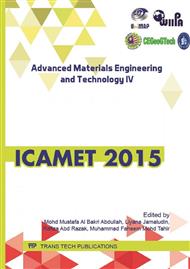p.131
p.136
p.142
p.146
p.151
p.159
p.164
p.169
p.174
Response Surface Methodology (RSM) in Fabrication of Nanostructured Silicon
Abstract:
In this paper, a respond surface methodology (RSM) model has been developed using three levels Box-Benkhen experimental design (BBD) technique to study the influence of several metal-assisted chemical etching (MACE) process variables on the properties of nanostructured silicon (Si) wafer. Five process variables are examined i.e. concentrations of silver (Ag), hydrofluoric acid (HF), deposition time, H2O2 concentration and etching time as a function of etching rate. Design-Expert® software (version 7.1) is used in formulating the RSM model of five factors with 46 experiments. A regression quadratic model is developed to correlate the process variables where the most significant factors are identified and validated using analysis of variance (ANOVA). The model for etching rate is found to be significant with R2 of 0.8, where both Ag concentrations and etching time are the major influence.
Info:
Periodical:
Pages:
151-155
Citation:
Online since:
May 2016
Keywords:
Price:
Сopyright:
© 2016 Trans Tech Publications Ltd. All Rights Reserved
Share:
Citation:


